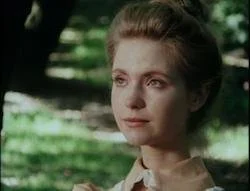Mina
Count Dracula (1977) is a British television adaptation of Bram Stoker’s canonical vampire tale. For Tim Lucas, who recommended I check out this awkward video/film hybrid, it does greater justice to the original Dracula than any other filmic version. “Judi Bowker,” claims Lucas, “is the only real Mina ever represented in film, and it makes her corruption all the more tragic.” Dracula isn’t the central focus. This gives Bowker’s Mina Harker — who might accurately be described as a doll-like, even pat incarnation of honey-haired innocence — the chance to evince a modern paradigm, becoming, by immeasurably small degrees, a model of high-minded vampirism. Mina communes, unprotected, with madness AKA the fly-eating menace called Renfield. Surviving the encounter with her true opposite number (normally Dracula himself), she does so by moving him with frankness: “I was very interested in what you were saying about Eternal Life… I feel we understand each other”. It’s a finely turned performance echoed satisfyingly by the soundtrack’s Ondes Martenot, more human and throaty than any other electronic instrument, here centralizing a woman’s existential experience — drawn from, but not solely dependent on, Stoker’s original late-Victorian metaphysics. Even Count Dracula’s hybrid format, then-standard for English television, seems appropriate to Mina’s curiously doubled existence as she glides along an ethical Mobius strip like an enlightened somnambulist.
by Daniel Riccuito

